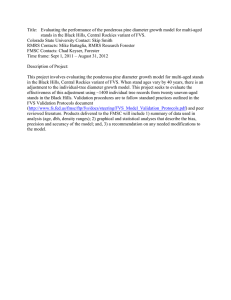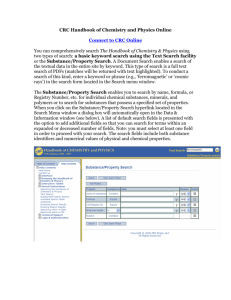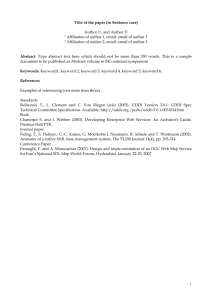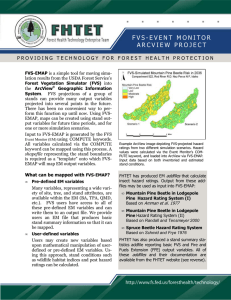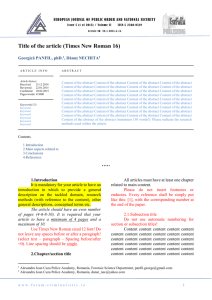Climate-FVS Version 1: Notes for Users Nicholas L. Crookston, RMRS-Moscow
advertisement
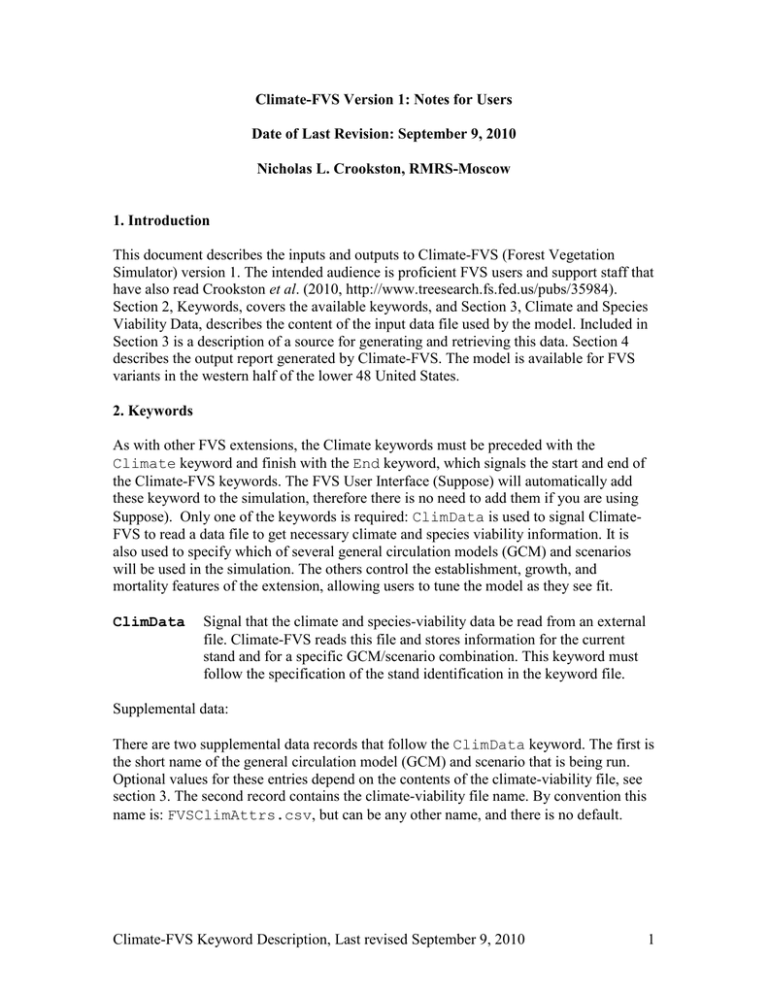
Climate-FVS Version 1: Notes for Users Date of Last Revision: September 9, 2010 Nicholas L. Crookston, RMRS-Moscow 1. Introduction This document describes the inputs and outputs to Climate-FVS (Forest Vegetation Simulator) version 1. The intended audience is proficient FVS users and support staff that have also read Crookston et al. (2010, http://www.treesearch.fs.fed.us/pubs/35984). Section 2, Keywords, covers the available keywords, and Section 3, Climate and Species Viability Data, describes the content of the input data file used by the model. Included in Section 3 is a description of a source for generating and retrieving this data. Section 4 describes the output report generated by Climate-FVS. The model is available for FVS variants in the western half of the lower 48 United States. 2. Keywords As with other FVS extensions, the Climate keywords must be preceded with the Climate keyword and finish with the End keyword, which signals the start and end of the Climate-FVS keywords. The FVS User Interface (Suppose) will automatically add these keyword to the simulation, therefore there is no need to add them if you are using Suppose). Only one of the keywords is required: ClimData is used to signal ClimateFVS to read a data file to get necessary climate and species viability information. It is also used to specify which of several general circulation models (GCM) and scenarios will be used in the simulation. The others control the establishment, growth, and mortality features of the extension, allowing users to tune the model as they see fit. ClimData Signal that the climate and species-viability data be read from an external file. Climate-FVS reads this file and stores information for the current stand and for a specific GCM/scenario combination. This keyword must follow the specification of the stand identification in the keyword file. Supplemental data: There are two supplemental data records that follow the ClimData keyword. The first is the short name of the general circulation model (GCM) and scenario that is being run. Optional values for these entries depend on the contents of the climate-viability file, see section 3. The second record contains the climate-viability file name. By convention this name is: FVSClimAttrs.csv, but can be any other name, and there is no default. Climate-FVS Keyword Description, Last revised September 9, 2010 1 AutoEstb Signal that Climate-FVS automatic establishment logic is turned on and that the base FVS automatic establishment features are turned off. If this keyword is not used, Climate-FVS establishment features are turned off. Field 1: The stocking threshold, expressed as a percentage of full stocking. If stand stocking is below this value, Climate-FVS plants new trees, default is 40 %. Field 2: The number of trees per acre that are planted. The species planted are determined by Climate-FVS and depend on the viability data; default is 500 trees. Field 3: The number of species to establish, default is 4. Note: GrowMult The logic with in Climate-FVS in additions to the fields specified by the AutoEstb keyword, generate the number of seedlings by species, the PLANT keyword in the Establishment model is the vehicle in which the trees are actually added to the projection. Specify a species-specific adjustment of the growth-rate multiplier computed by Climate-FVS. The details of the implementation are defined below. Three examples illustrate how to use this adjustment: 1) code a zero to turn off the Climate-FVS impacts on growth, 2) code 0.9 if you want the 90 % of Climate-FVS impact to be used, or 3) code 1.5 if you want the Climate-FVS impact to be 150 % of its original value. The growth rate adjustment is applied to the height growth for small trees and the diameter growth for large trees. Field 1: Species code to which the multiplier is applied. Default = All. Field 2: The adjustment factor, blank implies zero. Default = 0. Details: let xi be a growth rate multiplier applied to tree i, ci be the growth rate multiplier computed by Climate-FVS, and mi be the value specified in field 2 of this keyword. When the GrowMult keyword is not specified it is assumed, mi = 1.0 (be careful, mi = 0.0 if the keyword is used and field 2 is left blank). The value of xi is computed as follows: xi = 1 – (( 1 – ci ) mi ). MortMult Specify a species-specific mortality multiplier. The product of this value and the mortality rate computed by the Climate-FVS becomes the climatecaused mortality rate for trees of the species. FVS uses this mortality rate if it is larger than the mortality rate otherwise computed by FVS. Therefore, you can turn off the climate-caused mortality feature for a species by setting this multiplier to zero. Climate-FVS Keyword Description, Last revised September 9, 2010 2 Field 1: Species code to which the multiplier is applied. Default = All. Field 2: The multiplier, blank implies zero. Default = 0. MxDenMlt Specify an adjustment of the maximum density multiplier computed by Climate-FVS. The details of the implementation follow the pattern for GrowMult. Field 1: The adjustment factor, blank implies zero. Default = 0. ClimRept Generates the Climate-FVS output report (as described in section 4.0). 3. Climate and Species Viability Data File This section describes the general specifications for the climate and species viability data file. Following the specifications, a source for files that comply with these specifications is presented. Climate-FVS does not require users to use the source specified and it is possible for users to edit the data from the source prior to using that data in Climate-FVS. Indeed, a user can supply new information or edit the names of the scenarios, the climate data, the viability data, or any of these in combination so long as the requirements of the general specification are met. 3.1 General specification The climate and species viability data file contains sets of climate information for contemporary climate and for 3 points in future time, for a total of 4 data records per set. Sets are labeled by the stand identification to which they apply and the short name of the GCM and scenario they represent. There can be many sets in the file. Logic in ClimateFVS scans the file for the stand being simulated and for the GCM and scenario desired, storing the information needed for the simulation. Each time period is labeled with a year. Values associated with the earliest year are used when simulated time proceeds the earliest year found in the file and values associated with the latest year are used when simulated time exceeds the latest year in the file. Within the time span covered by the input data, linear interpolation is used to get values for simulated years that do not coincide with one of the four years specified in the file. The file format must be comma separated values (csv). The first line is a header that identifies the contents of the columns. Climate-FVS assumes that the order of the first three columns are as shown in table 1, but the other columns may be in any order so long as the column identifications are exactly as shown in table 1 (they are case sensitive and exact matches are made). Not all columns in table 1 are used; those that are used are identified in the output. Climate-FVS Keyword Description, Last revised September 9, 2010 3 Generally two kinds of information are present: climate data and species viability data. Short names for both are used to identify the contents of each column. The short names for the climate date are shown in table 1 and species abbreviations for the viability data are listed in table 2 (presented in the next section). Note that the list in table 2 is not exhaustive, columns for other species may be added and columns for species that are present at the site, but whose presence should be ignored by the model can be removed from the file. The species viability data are numeric scores between 0.0 and 1.0, where zero signifies that the species is not found in places with the corresponding climate and 1.0 signifies that the climate is consistent with places where the species is found. Note that ClimateFVS does not compute the viability scores; these climate data and the scores are required input. Table 1. Column names used in the Climate and Species Viability Data file; all temperature values are in centigrade and precipitation measures are in mm. Column Definition identification StandID The stand identification (case sensitive) Scenario The scenario short name (see table 3) Year The year this data record corresponds with mat Mean annual temperature map Mean annual precipitation gsp Growing season precipitation mtcm Mean temperature of the coldest month mmin Mean minimum temperature mtwm Mean temperature of the warmest month mmax Mean maximum temperature sday Julian date of first frost-free day in the spring ffp Number of frost-free days dd5 Degree days above 5 degrees centigrade gsdd5 dd5 accumulated within the frost-free period d100 Julian date that dd5 reaches 100 dd0 Degree days below 0 degrees FIACD1 FIA species abbreviation for the first species (see table 2) … Additional FIA species abbreviations (see table 2) FIACDn FIA species abbreviation for the nth species (see table 2) pSite The predicted site index, used to compute proportionate change, see Crookston et al. 2010, p. 1204. Climate-FVS Keyword Description, Last revised September 9, 2010 4 3.2 Data available from the Moscow Forestry Science Laboratory Web Site. A source of the climate and species viability data file is at this web address: http://forest.moscowfsl.wsu.edu/climate/customData/fvs_data.php. Instructions are present on the web site. In general, you first prepare a file of location information for each stand, send the file to the web site, receive the data back from the site, and make the file available to FVS to read. The location file specification is as follows: stand (or location) identification, longitude in decimal degrees, latitude in decimal degrees, and elevation in meters. See the web site for details. Species viability scores are computed for the species listed in Table 1. Not all are returned, however. Those species that are not viable (having a score below 0.1) in any stand in your list, for anytime, and any climate scenario, are removed. The column names in the file are the corresponding FIA species abbreviations and are always in capital letters. Table 2. Species list that may be used in Climate-FVS. Common name Scientific name Alaska cedar Alligator juniper Bigleaf maple Bigtooth maple Blue oak Blue spruce Brewer spruce Bristlecone pine California black oak California buckeye California-laurel California red fir Canyon live oak Cherry Coast live oak Corkbark fir Coulter pine Curlleaf mountainmahogany Douglas-fir Emory oak Engelmann spruce Gambel oak Golden chinkapin Grand fir Chamaecyparis nootkatensis Juniperus deppeana Acer macrophyllum Acer grandidentatum Quercus douglasii Picea pungens Picea breweriana Pinus aristata Quercus kelloggii Aesculus californica Umbellularia californica Abies magnifica Quercus chrysolepis Prunus sp. Quercus agrifolia Abies lasiocarpa var. arizonica Pinus coulteri Cercocarpus ledifolius FIA species abbreviations CHNO JUDE2 ACMA3 ACGR3 QUDO PIPU PIBR PIAR QUKE AECA UMCA ABMA QUCH2 PRUNU QUAG ABLAA PICO3 CELE3 Psuedotsuga menziesii Quercus emoryi Picea engelmannii Quercus gambelii Castanopsis chrysophylla Abies grandis PSME QUEM PIEN QUGA CHCH7 ABGR Climate-FVS Keyword Description, Last revised September 9, 2010 5 Incense cedar Interior live oak Jeffrey pine Knobcone pine Limber pine Lodgepole pine Mesquite Mexican blue oak Mountain hemlock New Mexico locust Noble fir Oneseed juniper Oregon ash Oregon white oak Pacific dogwood Pacific madrone Pacific silver fir Pacific yew Paper birch Pinyon pine Plains cottonwood Ponderosa pine Port-Orford-cedar Quaking aspen Red alder Redberry juniper Rocky Mountain juniper Rocky Mountain maple Shasta red fir Silverleaf oak Calocedrus decurrens Quercus wislizeni Pinus jeffreyi Pinus attenuata Pinus flexilis Pinus contorta Prosopis sp. Quercus oblongifolia Tsuga mertensiana Robinia neomexicana Abies procera Juniperus monosperma Fraxinus latifolia Quercus garryana Cornus nuttallii Arbutus menzeisii Abies amabilis Taxus brevifolia Betula papyrifera Pinus edulis Populus deltoides ssp. monilifera Pinus ponderosa Chamaecyparis lawsoniana Populus tremuloides Alnus rubra Juniperus erythrocarpa Juniperus scopulorum Acer glabrum Abies magnifica var. shastensis Quercus hypoleucoides CADE27 QUWI2 PIJE PIAT PIFL2 PICO PROSO QUOB TSME RONE ABPR JUMO FRLA QUGA4 CONU4 ARME ABAM TABR2 BEPA PIED PODEM PIPO CHLA POTR5 ALRU2 JUCO11 JUSC2 ACGL ABSH QUHY Singleleaf pinyon Pinus monophylla PIMO Sitka spruce Southwestern white pine Subalpine fir Subalpine larch Sugar pine Tanoak Tesota-Arizona ironwood Utah juniper Valley California white oak Western hemlock Western juniper Western larch Western paper birch Western redcedar Picea sitchensis Pinus strobiformis Abies lasiocarpa Larix lyallii Pinus lambertiana Lithocarpus densiflorus Olneya tesota Juniperus osteosperma Quercus lobata Tsuga heterophylla Juniperus occidentalis Larix occidentalis Betula papyrifera var. commutata Thuja plicata PISI PIST3 ABLA LALY PILA LIDE3 OLTE JUOS QULO TSHE JUOC LAOC BEPAC THPL Climate-FVS Keyword Description, Last revised September 9, 2010 6 Western white pine White alder Whitebark pine White fir Willow Pinus monticola Alnus rhombifolia Pinus albicaulis Abies concolor Salix sp. PIMO3 ALRH2 PIAL ABCO SALIX Data files generated from the Moscow Forestry Sciences Laboratory contain 7 possible values for scenario (the second column described in Table 1). These are listed in table 3. Table 3. GCM model/scenario names. Short name GCM group name and scenario identification CGCM3_A1B Canadian Center for Climate Modeling and Analysis, scenario A1B CGCM3_A2 Canadian Center for Climate Modeling and Analysis, scenario A1 CGCM3_B1 Canadian Center for Climate Modeling and Analysis, scenario B1 GFDLCM21_A2 Geophysical Fluid Dynamics Laboratory, scenario A2 GFDLCM21_B1 Geophysical Fluid Dynamics Laboratory, scenario B1 HADCM3_A2 Hadley Center/World Data Center, scenario A2 HADCM3_B2 Hadley Center/World Data Center, scenario A2 4.0. Output reports The effects of changing climate on growth, mortality, and regeneration are evident in the standard FVS output reports. Climate-FVS provides two outputs, one that displays the data read from the external climate and species viability data file (see section 3), and another report designed to display how the model is working. The first of these outputs is generated when the ClimData keyword is used. Figure 1 is an illustration of that information, except that several lines and columns have been deleted from the figure so that it will fit herein. Climate-FVS Keyword Description, Last revised September 9, 2010 7 CODES: YEAR 1990 2030 2060 2090 *USED* mat map 3.8 867.0 5.5 893.0 7.5 921.0 8.7 1029.0 *USED* gsp 322.0 310.0 328.0 309.0 *USED* mtcm -6.2 -5.1 -2.8 -1.6 *USED* mmin -11.5 -10.0 -7.4 -6.1 mtwm 15.0 17.3 19.0 20.6 mmax 25.1 28.2 29.6 31.4 ...Several lines and columns were deleted in this figure. CODES: YEAR 1990 2030 2060 2090 ABCO 0.021 0.015 0.039 0.128 CODES: YEAR 1990 2030 2060 2090 *USED* pSite 61.3 63.9 71.6 82.2 4=GF ABGR 0.945 0.950 0.935 0.699 9=AF ABLA 0.686 0.536 0.110 0.060 ABLAA 0.030 0.000 0.044 0.003 ABPR 0.014 0.019 0.106 0.119 20=MM ACGL 0.951 0.950 0.574 0.424 ACGR3 0.012 0.060 0.051 0.075 SPECIES WITHOUT ATTRIBUTES: FVS INDEX= 19, ALPHA CODE=CO , FIA CODE=POPUL FVS INDEX= 22, ALPHA CODE=OH , FIA CODE=2TD FVS INDEX= 23, ALPHA CODE=OS , FIA CODE=2TE Figure 1. Abbreviated output generated when the ClimData keyword is used. Check this output to learn what climate variables are selected (see Table 1, lower case letters, by convention). This section also contains the viability scores (upper case) of species in the file, and the predicted site index (see Crookston et al. (2010) for information on how these data are used in Climate-FVS). Many more climate variables than those being used in the current Climate-FVS code can be present, those being used by the model are marked with *USED*. In Fig. 1, for example, mat (mean annual temperature) is being used and map (mean annual precipitation) is not. Most of the climate variables were likely used to compute the viability scores, however only those marked as being used are drivers in the growth calculations. There can also be many more species in the file than are recognized by a specific FVS variant. Those recognized by the variant being used are indicated with a notation above the species code. For example in this example, grand fir has the FIA abbreviation ABGR, it is species number 4 in FVS and the FVS species code is GF. At the end of the table, species that are recognized by FVS but have no viability data are listed. In this case, generic cottonwood (FIA code POPUL) as well as FVS species 22 and 23 (other hardwood and other softwood) have no viability data. If tree records are present in the FVS run coded with these species codes, they will be grown as if the viability score was 1.0 for the entire time period. Climate-FVS Keyword Description, Last revised September 9, 2010 8 The second output report, created by including the ClimRept keyword, is illustrated in Fig. 2. Table 4 provides detailed information on the column headings. CLIMATE-FVS VERSION 1.0 VIABILITY AND EFFECTS REPORT -----------------------------------------------------------------VIABILITY EXISTING EXISTING PROB GROWTH AUTOESTB YEAR SPECIES SCORE(0-1) BA/A TPA MORT MULT TPA ---- -------- ---------- -------- -------- ------ ------ -------2005 WP 0.530 0.00 0.0 0.0000 1.000 0.0 ...Lines deleted, there is one line for each species within a cycle 2005 MM 0.950 0.00 0.0 0.0000 1.000 110.7 ...Lines deleted, there is a set of lines for each FVS cycle 2095 2095 2095 2095 2095 2095 2095 WP WL DF GF RC MM PB 0.631 0.452 0.737 0.699 0.691 0.424 0.600 0.00 0.00 106.86 51.00 0.00 0.00 0.00 0.0 0.9 73.3 27.3 0.0 0.0 0.0 0.0000 0.1600 0.0000 0.0000 0.0000 0.2533 0.0000 1.000 0.840 0.672 0.656 1.000 1.000 1.000 54.8 0.0 79.9 70.9 69.0 0.0 0.0 Figure 2. Climate-FVS example output. Table 4. Column heading descriptions for the Climate-FVS output illustrated in Fig. 2 Title Description Year The year corresponding to the first year of the FVS cycle in which the output is generated. Species The FVS species code. Viability The species climate viability score which ranges from 0 to 1. Score (0-1) Existing BA/A Existing TPA Prob Mort Growth Mult Autoestb TPA The basal area per acre at the beginning of the FVS cycle The trees per acre at the beginning of the FVS cycle The probability that the tree will die due to low viability scores (this is a 10-year rate, regardless of the length of the cycle). This number will reflect values coded using the Climate-FVS MortMult keyword. Note that it does not display the base model mortality rate for the species and also note that the value displayed will be applied during the model run only when it implies a mortality rate that is higher than the base model rate. The proportion of FVS growth that trees of this species will get. This number reflects values coded using the Climate-FVS GrowMult keyword. This is the number of trees of a given species that would be inserted in to the FVS simulation if (1) the AutoEstb feature were turned on, and (2) the density were low enough to trigger establishment. Climate-FVS Keyword Description, Last revised September 9, 2010 9 References Crookston, Nicholas L.; Rehfeldt, Gerald E.; Dixon, Gary E.; Weiskittel, Aaron R. 2010. Addressing climate change in the forest vegetation simulator to assess impacts on landscape forest dynamics. Forest Ecology and Management. 260: 1198-1211. Climate-FVS Keyword Description, Last revised September 9, 2010 10
